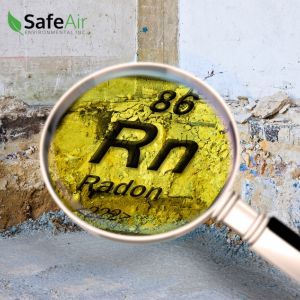How to Address High Radon Levels Detected During Home Air Quality Testing in Older Homes
Posted in Radon Testing, on September 17, 2024
One of the specialized branches of home air quality testing that the SafeAir team recommends to clients with older homes is radon testing. Older homes across the GTA often have higher radon levels because of age-related issues. Testing for radon gas is a simple, convenient, and safe way to ascertain if you are at risk of radon-related health problems. The only way to know if your home is affected by radon gas is to have professional testing performed — there are no visual effects, smells, or sounds to alert you otherwise.
Radon - A Crash Course
 Radon gas is made by uranium deposits deep underground. This gas enters the atmosphere by floating through soil and rocks and is harmless when it dissipates outdoors. However, radon gas often concentrates in homes because of sub-grade basements and ground floors that form pockets of negative pressure in the earth. It’s when radon concentrates that it becomes dangerous to our health.
Radon gas is made by uranium deposits deep underground. This gas enters the atmosphere by floating through soil and rocks and is harmless when it dissipates outdoors. However, radon gas often concentrates in homes because of sub-grade basements and ground floors that form pockets of negative pressure in the earth. It’s when radon concentrates that it becomes dangerous to our health.
Radon’s Health Risks
Radon gas is radioactive and begins to decay when it reaches the Earth’s atmosphere. However, the gas particles are microscopic and very easy to breathe in. Once they enter the nose, mouth, throat, and lungs, radon gas begins the decay process, and as it does so, it damages delicate tissues and causes inflammation. Over time, this process of damage and inflammation causes changes at the cellular level that lead to lung cancer and serious disease.
Unfortunately, there are no early symptoms of radon poisoning or exposure — when you have symptoms, it’s generally too late to reverse the damage. This serious effect is the reason why the SafeAir team is passionate about radon testing — by helping you understand your risk today, you can make changes that will positively affect you and your family’s health for decades.
Why Old Houses Are at Greater Risk of Radon Gas
Any home, new or old, can be affected by radon gas. But it’s equally as true that older homes tend to have greater concentrations and be affected more frequently than new ones — why is this?
In our experience, your house’s age can play a role in your risk of exposure to radon gas. Radon most often enters the home through the foundation, water system, doors, or windows, especially when these features are below grade. Minuscule cracks, gaps, or damage are all that’s needed to let radon in — you may not even be able to see the entry point.
Older homes built before we understood the risk of radon gas and the aging process, seasons, and landscaping changes can all affect how and why radon enters your home. Building materials have also changed a great deal, and older foundations or homes with sump pumps, dirt crawlspaces, or other, more old-fashioned features may increase your danger.
Radon Strategies for Old Homes
If you have an older home, the SafeAir team recommends having a complete home air quality test that seeks to understand and quantify your risks across a number of air quality issues. Air quality testing can help identify household hazards common in older buildings, such as lead paint or asbestos, as well as modern concerns about particulates and VOCs.
Radon testing is a passive process that happens over a 3-6 month period. SafeAir installs a small device - not unlike a smoke alarm - in a lower level of your home, where it passively records radon levels during the testing window. Afterward, we send this device to a third-party lab for analysis.
Health Canada’s radon safety guideline is 200 Becquerels per cubic metre or less. If your results indicate your home is above or close to this level, we’ll advise you on the next steps you can take to reduce or eliminate your risk.
Some common strategies include sealing foundation gaps, using radon-filtering devices at your water pump, or installing fans and increasing airflow. Each home needs a unique approach, and our team will be happy to help you decide on one that fits your needs and budget.
Reduce Your Radon Risk Today
Radon gas is prevalent across Southern Ontario because of the bedrock and Canadian Shield on which our cities lie. Homes of all ages and types can be affected, from rural cottages to downtown semis. No matter what type of building you live in, home air quality testing is a valuable service to help you assess hidden health risks. To learn more about radon testing or speak to our team, call or email SafeAir today.

